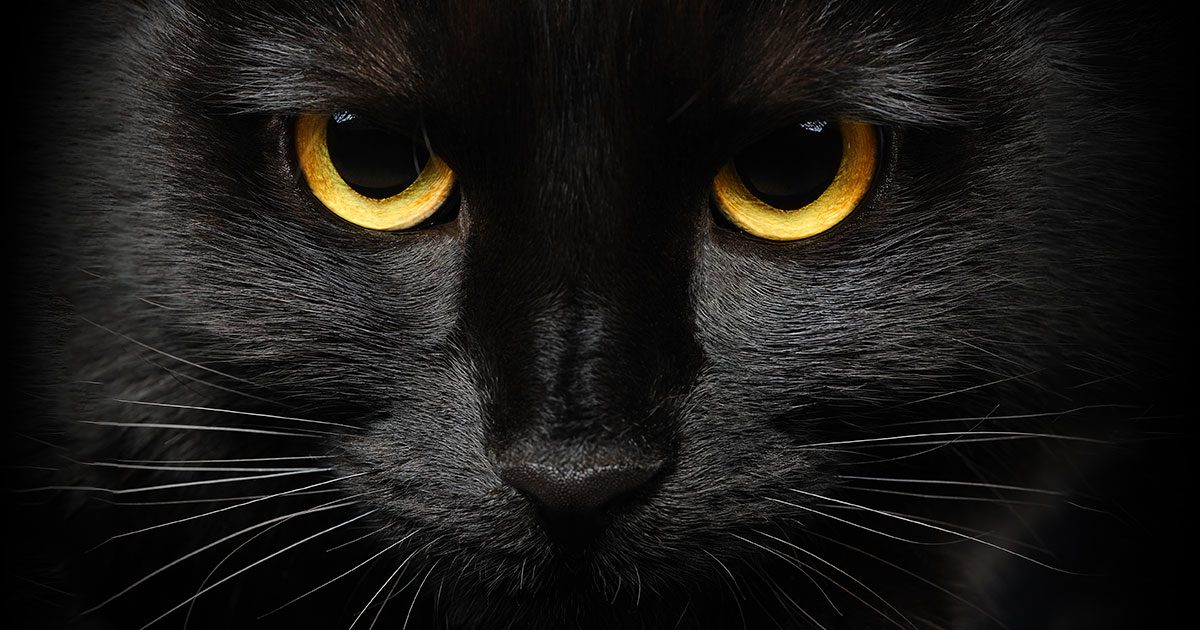Humans have had a love–hate relationship with cats, especially black cats, for millennia. First prized as skillful predators and affectionate companions, black cats were later vilified for being witches in disguise or witches’ familiars (spirits or demons who serve as witches’ spies and companions). Today, black cats (and witches) are a staple of Halloween costumes, decorations, scary stories and party themes, all of which reinforce the misguided superstitions that have surrounded black cats.
What did black cats do to deserve their dark reputation? Read on to learn more about the history behind black cat mythology.
Back to the origins of human civilization and cat domestication?
Superstitions can be negative or positive, depending on where and when you live. That’s especially true for black cats. Although the origins of black cat superstitions are difficult to trace, many historians think the ebony feline’s bad reputation stems from mythology and the beginnings of religion. Egyptian, Greek, Roman, Celtic and Norse mythology all reference black cats in one way or another.
The myths date back to ancient times. In the Fertile Crescent of the Middle East (modern-day Iraq, Israel, Palestine, Syria, Lebanon, Egypt and Jordan), the development of farming during the Neolithic period allowed people to stockpile grains. These stores attracted mice and rats, which in turn drew wildcats to human settlements. The result was a mutually beneficial arrangement that led to cat domestication. Eventually, cats were welcomed into homes where they preyed on rodents, scorpions and snakes (particularly cobras) and became valued companions.
Ancient Egyptians revered and worshipped cats
As cat owners know, even the most domesticated cats have retained their independence. Historians think ancient Egyptians, who were fascinated by divine opposites, recognized a duality in cats — fiercely independent predators who are also loyal and affectionate guardians. This dichotomy may help explain why cats became associated with several Egyptian deities and were commonly found as part of ancient Egyptian social and religious practices for more than 3,000 years.
Bastet, an important Egyptian goddess, is usually portrayed as a black cat or having a black cat’s head on a woman’s body. Historians speculate this is how the black cat first reached its special status. From around the 950s BCE (before the Common Era) onward, Bastet grew in popularity, and along with her, domestic cats were increasingly considered sacred. Cat worship reached its peak in Egypt under the rule of Alexander the Great.
Greek and Roman mythology linked cats to spirit world, too
The Egyptians weren’t the only ones who thought cats had a special connection to the spirit world. In Greek mythology, a cat was the familiar of Hecate, the goddess of magic, witchcraft and death. Hecate’s cat had once been Galinthias, a servant or midwife who interfered with the goddess Hera’s plan to delay the birth of Heracles, the son of Zeus. Some stories say the three goddesses of fate turned Galinthias into a polecat (a type of weasel) as punishment for lying to them, while other stories indicate Hera changed Galinthias into a black cat.
Ancient Romans respected cats for their predatory prowess and also saw them as sacred animals. Because of cats’ independent nature, they were associated with liberty and divinity, and so cats were the only animals allowed to walk freely around Roman temples. The goddess of liberty, Libertas, was often shown with a cat at her feet. Another story tells of how Diana, goddess of the hunt, escaped from an evil dragon-like creature by transforming herself into a cat.
Demise of paganism starts a slide into dark lore
Once Egypt became a Roman province, cats and religion began to separate. Roman emperors issued a series of rulings during the fourth and fifth centuries CE (Common Era) that gradually decreased Egyptians’ practice of paganism. Temples such as the one dedicated to Bastet were impounded and sacrifices to Egyptian gods and goddesses were prohibited.
Christianity became the official religion of Rome in 380 CE. Since cats were associated with paganism, people became suspicious of them. Historians have theorized that early Christians found the independent nature of cats to be a willful rebellion against religious teachings, which said that Adam (and subsequently, all men) had dominion over all animals.
Once bright and benevolent, the cat’s reputation darkens
The rise of the Roman Empire was accompanied by the spread of Christianity across Europe. What does this have to do with black cats? Christianity delegitimized pagan customs and traditions in Europe as it had in Egypt. Cats, which had become pagan symbols because of their links to pagan goddesses, were vilified along with all other pagan symbols.
Then came the Middle Ages, the medieval period of European history between the fall of the Roman Empire and the beginning of the Renaissance (between fifth and 15th centuries). Also known as the Dark Ages, spiritual beliefs combined with a lack of scientific understanding about nature produced many superstitions. During this time, black cats were linked to witches, witchcraft, the devil and evil.
Some historians suggest the connection between black cats and black magic started when people became sick and died. Needing an explanation for these events, people looked for something or someone (witches?) to blame. They didn’t know what we now know about the many causes of disease.
Although medicine appears to predate the earliest civilizations, few records document the medical practices of early humans. Historical evidence suggests the ancient Mesopotamians and ancient Egyptians used both magic and medicinal treatments to treat illnesses. Since then, several theories were proposed to explain the causes of disease. But it wasn’t until the Middle Ages that physicians proposed the beginnings of the “germ theory of disease” — that microorganisms known as pathogens or “germs” lead to disease. (Remember, physicians didn’t have microscopes back then; microscopes were invented around 1590.)
The cat’s reputation worsened as the Catholic Church dealt with heresy — namely, witchcraft and devil worship. Around 1233, Pope Gregory IX issued a papal bull, Vox in Rama, that condemned a contemporary surge in devil worship. Some accounts of this papal bull declare black cats to be an incarnation of the devil; others claim the pope was simply describing the use of black cats in evil rituals. Either way, the result was the same: people began to fear black cats and to kill them by the thousands over the following century.
Making matters worse for black cats, in 1484, Pope Innocent VIII incited more anti-cat prejudice with his papal bull Summis Desiderantes Affectibus, which sanctioned the prosecution of witchcraft in Germany. Cats owned by alleged witches were prosecuted with their owners.
Fear of black cats traveled to the United States with the Puritans, who were on guard against all things related to the devil, including witches and their black cat familiars. By the time of the famous witch trials of the 16th and 17th centuries, simply owning a black cat was enough to get a “witch” and cat condemned to death.
Black cat myths persist yet today
A common myth that circulates around Halloween suggests satanic cults sacrifice black cats on Halloween. Rescue groups and law enforcement agencies are unable to provide statistics about Halloween-related animal killings or abuse. However, the consensus among shelter workers and rescue groups is that acts of animal abuse directed at cats rise slightly around Halloween and have more to do with cruel people than with cult sacrifices. Some shelters limit cat adoptions in the days leading up to Halloween. Other shelters are simply extra cautious because they don’t want to deprive black cats of the opportunity for a new forever home.
Animal shelters and rescue groups also fear people will adopt black cats to use as Halloween accessories and decorations, only to abandon them afterward. To combat this concern, shelters may more closely scrutinize potential adopters or even defer cat adoptions until after Halloween.
Superstitions about black cats have existed for millennia and still persist today. None of these myths are based in fact, reality or science, and are not deserved. The good news is that we now know owning a cat — regardless of fur color — benefits human health. Cats help lower blood pressure, reduce anxiety and stress, and decrease feelings of loneliness.
Those are facts worth perpetuating!
RELATED POST: Debarking Pet Myths: The Truth About Cats and Their Nine Lives







